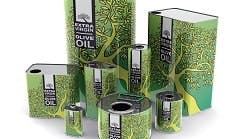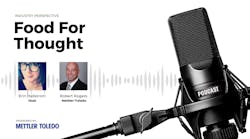Metal packaging is on a roll. Some brand owners are coming out with structural features that improve their package's convenience, portability or product delivery. Others are opting for package shapes that not only improve functionality but also reinforce the brand.
"Metal packaging is increasingly popular among our olive oil customers because it offers exceptional design opportunities," says Véronique Curulla, marketing director, Crown Aerosols and Speciality Packaging Europe, part of Crown Holdings Inc., Philadelphia. Design options include package structures as well as graphics.
Crown currently supplies tinplate (tin-coated steel) packaging to several olive oil companies, including La Organic, Merula and Hacienda Queiles, all based in Spain, and Prince Albert Olives, which is in South Africa.
Tins in a broad range of shapes, diameters and heights are available for these kinds of products, but "typically, olive oil brands select either cylindrical or oblong packaging formats," Curulla says. "We also have the ability to design irregularly shaped tins and to customize packaging with unique decorative finishes for a distinct look and feel on store shelves."
Metal packaging's product-protection features — its ability to safeguard products from light and oxygen — are attractive to processors of sensitive products like olive oil. And compared to glass, metal packaging is lighter to ship and resists breakage.
Tied with a bow
The desire for custom shapes isn't limited to food companies. Anheuser-Busch, St. Louis, made news earlier this year with it unique bowtie-shaped Budweiser can.
The can, which leverages the brand's bowtie logo, has a subtle hourglass shape that sets it apart from conventional aluminum beverage cans. Introduced in May, the bowtie can holds 11.3 oz. and features an 11-degree angle at its waistline. The package was developed to complement, not replace, the brand owner's 12-oz. cans.
"The goal at launch was to drive trial, which we call reappraisal, to get people to reconsider … putting Budweiser back in their [brand] set," says Pat McGauley, vice president of innovation for Anheuser-Busch.
Twenty-something consumers were a particular focus for the new can. "Millennials are more open to trying new things, and they have more brands in their overall set. They're much more open to change," McGauley says. "They're open to trial of new products, so it was a way to drive reappraisal with new, legal-drinking-age beer consumers … [and if they] haven't had a Budweiser, give them a reason."
He adds, "Females like [the bowtie can] because it's shapely. Males like it because it fits in their hand nicely. So it wasn't gender-biased at all. It ended up being very co-ed, and again, addressing what millennials are looking for."
The idea of using the can's shape to embody the Budweiser logo is part of Anheuser-Busch's long-term plan for the brand. McGauley envisions a future when consumers, if shown an all-white version of the bowtie can, will know the brand. He explains: "We're working to build what we call ‘structural integrity' where, just from looking at the shape, you know it's Budweiser."
The bowtie cans are produced at the Newburgh, N.Y., plant of Metal Container Corp., a subsidiary of Anheuser-Busch Packaging Group, using custom-made equipment. Shaping the cans takes 16 steps, and each can requires twice as much aluminum as a standard beer can.
Vents aplenty
Other beer brand owners also are making structural changes to their cans, specifically the can ends, to improve consumer satisfaction. Several have developed can ends with venting features that eliminate glugs while pouring.
Ball Corp., Broomfield, Colo., has worked closely with Chicago-based MillerCoors LLC on venting designs. "We had the Punch Top end, which is on Miller Lite," says Jared Brody, Ball's marketing and innovation manager for North America. "You basically just punch a hole in the top [of the can], and it helps to smooth out the pour." The can, which launched in 2012, incorporates a small, punchable vent tab.
Several years earlier, Ball had developed the SmoothPour Vented Wide Mouth can end for Coors Light. "That technology uses vent tubes, so it allows air in as the beer is being poured, and again, the goal there is to smooth out the pour," Brody says.
Ball recently built upon the SmoothPour technology to develop a double-vented, wide-mouthed can end. The feature is part of "The World's Most Refreshing Can" from Coors Light, which launched this May. The can also sports thermochromic, dual-stage cold indicators ("Cold" and "Super Cold"), the brand's Frost Brew liner and cold-activated mountain graphics.
Also this summer, for the Canadian market, Molson Coors Canada, Toronto, introduced its Vented End on cans of Coors Light and Molson Canadian. Molson Coors Canada developed this can end in conjunction with Crown, Cork & Seal, Philadelphia.
Molson Coors Canada's Vented End is engineered to make the pull-tab work not only in the conventional way but also as a tool to create a vent. The consumer opens the can as usual and then turns the red pull-tab so it's directly over the vent button. Pressing down on the tab, when it's in this position, opens an airway.
The Vented End is purportedly the first of its kind in the beer category in Canada. "We wanted to give our beer drinkers a packaging innovation that was fun and easy to use. The Vented Ends allow for a smoother pour," says Troy McCann, innovation manager at Molson Coors Canada.
The company distributed 50 million 473-ml Vented End cans throughout Canada during the summer months, "and initial consumer response has been great," McCann says. "People are always looking for packaging to do more for the product experience — and with this can, we've provided consumers the opportunity to unlock a smoother pour in a fun, engaging way."
A follow-up wave of distribution, begun in August, is rolling out 15-packs of Coors Light and Molson Canadian in 355-ml Vented End cans within the Canadian provinces of Ontario, New Brunswick, Prince Edward Island and Nova Scotia.
Separately, Anheuser-Busch has announced it will launch its own version of such a package — the 12-oz. Bud Light Vented Can. The company market-tested the can in Louisville, Ky., during the summer. The consumer opens the can using the pull-tab, then presses the tab back down against the top of the can to activate the vent. According to the company, the can will launch nationwide in the U.S. before the end of 2013.
Good-looking and functional
In other product categories, metal bottles are finding more applications. Vuka Intelligent Energy drinks, for example, launched in colorful 16-oz. Alumi-Tek aluminum bottles from Ball Corp. The format combines the best features of bottles and cans, with a wide mouth to drink from, a reclosable screw-top cap and no fear of breakage.
The lightweight bottle provides "the inherent benefits of cans. Drinks get colder faster. The recyclability is there," says Brody, of Ball. And although the Alumi-Tek package has been on the market for a few years, "it's still a relatively novel looking package, and so a lot of brands are using it as a way to differentiate themselves on-shelf, especially some of the newer players."
Vuka, Solana Beach, Calif., is in that group, he adds. Vuka "wanted to appeal to a more sophisticated adult audience that was interested in natural ingredients in an energy drink. And the Alumi-Tek bottle, especially with [Vuka's] really beautiful graphics, exudes that sophistication."
Slim-profile cans also are gaining popularity. Once again, the unconventional look and feel of the package, together with standout graphics, can help differentiate a brand.
Nutrié, Scottsdale, Ariz., took this route for its Fuel Premium Protein Shake, which launched in July. The company uses the Sleek aluminum can from Rexam, Chicago. Although the Fuel can holds 12 oz., it is more slender than a standard beverage can, and taller.
"The differentiation helps build brands on store shelves, and in addition, the Sleek cans are easy to grip and hold," says Greg Brooke, vice president of North American corporate affairs at Rexam.
The Fuel package also provides portability, durability and barrier protection from light — plus striking good looks. "What aluminum provides that other packaging materials don't is that reflective nature of colorful graphics, which truly stand out on a crowded store aisle," Brooke says. "It is also a superior environmental choice, with a recycle rate of 65 percent in the U.S., more than double that of any other beverage package."


